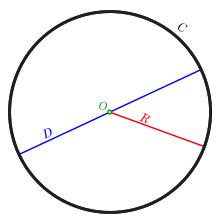Radius

In classical geometry, a radius (pl.: radii or radiuses)[a] of a circle or sphere is any of the line segments from its center to its perimeter, and in more modern usage, it is also their length. The name comes from the Latin radius, meaning ray but also the spoke of a chariot wheel.[2] The typical abbreviation and mathematical variable name for radius is R or r. By extension, the diameter D is defined as twice the radius:[3]
If an object does not have a center, the term may refer to its circumradius, the radius of its
For
The radius of the circle with perimeter (circumference) C is
Formula
For many geometric figures, the radius has a well-defined relationship with other measures of the figure.
Circles
The radius of a circle with area A is
The radius of the circle that passes through the three non-
where θ is the angle ∠P1P2P3. This formula uses the law of sines. If the three points are given by their coordinates (x1,y1), (x2,y2), and (x3,y3), the radius can be expressed as
Regular polygons
| n | Rn |
|---|---|
| 3 | 0.577350... |
| 4 | 0.707106... |
| 5 | 0.850650... |
| 6 | 1.0 |
| 7 | 1.152382... |
| 8 | 1.306562... |
| 9 | 1.461902... |
| 10 | 1.618033... |

The radius r of a regular polygon with n sides of length s is given by r = Rn s, where Values of Rn for small values of n are given in the table. If s = 1 then these values are also the radii of the corresponding regular polygons.
Hypercubes
The radius of a d-dimensional hypercube with side s is
Use in coordinate systems
Polar coordinates
The polar coordinate system is a
from a fixed direction.The fixed point (analogous to the origin of a
Cylindrical coordinates
In the cylindrical coordinate system, there is a chosen reference axis and a chosen reference plane perpendicular to that axis. The origin of the system is the point where all three coordinates can be given as zero. This is the intersection between the reference plane and the axis.
The axis is variously called the cylindrical or longitudinal axis, to differentiate it from the polar axis, which is the
The distance from the axis may be called the radial distance or radius, while the angular coordinate is sometimes referred to as the angular position or as the azimuth. The radius and the azimuth are together called the polar coordinates, as they correspond to a two-dimensional polar coordinate system in the plane through the point, parallel to the reference plane. The third coordinate may be called the height or altitude (if the reference plane is considered horizontal), longitudinal position,[7] or axial position.[8]
Spherical coordinates
In a spherical coordinate system, the radius describes the distance of a point from a fixed origin. Its position if further defined by the polar angle measured between the radial direction and a fixed zenith direction, and the azimuth angle, the angle between the orthogonal projection of the radial direction on a reference plane that passes through the origin and is orthogonal to the zenith, and a fixed reference direction in that plane.
See also
- Bend radius
- Filling radius in Riemannian geometry
- Radius of convergence
- Radius of convexity
- Radius of curvature
- Radius of gyration
- Semidiameter
Notes
References
- ^ "Radius - Definition and More from the Free Merriam-Webster Dictionary". Merriam-webster.com. Retrieved 2012-05-22.
- ^ Definition of Radius at dictionary.reference.com. Accessed on 2009-08-08.
- ^ Definition of radius at mathwords.com. Accessed on 2009-08-08.
- accessed on 2009-08-08.
- ISBN 1-58488-505-X, 9781584885054. Online versionaccessed on 2009-08-08.
- ISBN 0-395-77114-5.
- ISSN 1089-7674. Archived from the originalon 14 April 2013. Retrieved 9 February 2013.
...in cylindrical coordinates (r,θ,z) ... and Z=vbzt is the longitudinal position...
- S2CID 54814721. "[...]where r, θ, and z are cylindrical coordinates [...] as a function of axial position[...]"







